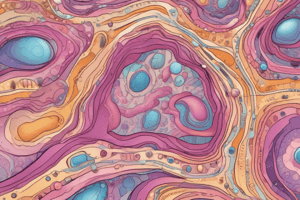Podcast
Questions and Answers
What is the primary function of epithelial tissue?
What is the primary function of epithelial tissue?
- To cover body surfaces and line cavities (correct)
- To store energy
- To produce hormones
- To facilitate gas exchange
What is the process of sectioning in histology?
What is the process of sectioning in histology?
- Applying stains to tissues
- Cutting tissue samples into thin slices (correct)
- Examining cells under a microscope
- Isolating DNA from tissue samples
Which type of staining is the most common in histological analysis?
Which type of staining is the most common in histological analysis?
- Silver staining
- Immunohistochemistry
- Gram staining
- Hematoxylin and eosin staining (correct)
What are the basic parts of a cell?
What are the basic parts of a cell?
What accurately defines the terms 'tissues' and 'organs'?
What accurately defines the terms 'tissues' and 'organs'?
Which statement accurately describes the rationale behind staining in histology?
Which statement accurately describes the rationale behind staining in histology?
Which type of epithelium is best suited for areas of high mechanical stress and abrasion?
Which type of epithelium is best suited for areas of high mechanical stress and abrasion?
In histological analysis, what is the significance of the sectioning process?
In histological analysis, what is the significance of the sectioning process?
Which component is not typically involved in the basic structure of all cells?
Which component is not typically involved in the basic structure of all cells?
What is the definition of 'tissue' in histological studies?
What is the definition of 'tissue' in histological studies?
Flashcards are hidden until you start studying
Study Notes
Basic Parts of a Cell
- Cells are the fundamental units of life, and all living organisms are made up of one or more cells.
- Cells possess various components, including a plasma membrane, cytoplasm, ribosomes, endoplasmic reticulum, Golgi apparatus, mitochondria, lysosomes, and a nucleus.
Tissues and Organs
- Tissues are groups of similar cells that work together to perform a specific function.
- Organs, on the other hand, are composed of different tissues working together for a common purpose.
Common Staining Process
- Hematoxylin and eosin (H&E) staining is a common technique for visualizing tissues under a microscope.
- Hematoxylin, a basic dye, stains acidic components of cells, like nuclei, blue.
- Eosin, an acidic dye, stains basic components, such as cytoplasm, pink.
- This allows differentiation between structures within the tissue.
Sectioning
- Sectioning is the process of cutting thin slices of tissue for microscopic examination.
- It is done using a microtome and allows for the visualization of internal structures.
Types of Epithelium
- Epithelium is a type of tissue that covers surfaces and lines cavities, providing protection, secretion, absorption, and filtration.
- Main types include:
- Simple squamous epithelium: Thin, single-layered, found in areas of diffusion, filtration, and secretion (e.g., lining of blood vessels).
- Stratified squamous epithelium: Multilayered, providing protection (e.g., skin).
- Cuboidal epithelium: Cube-shaped cells, involved in secretion and absorption (e.g., lining of kidney tubules).
- Columnar epithelium: Tall, rectangular cells, functions include secretion, absorption, and protection (e.g., lining of stomach).
- Transitional epithelium: Stretchable, found in areas that need to change shape (e.g., urinary bladder).
Basic Parts of a Cell
- Plasma membrane: Outer boundary, controls what enters and exits the cell.
- Cytoplasm: Gel-like substance containing organelles.
- Nucleus: Contains genetic material (DNA) for cell function.
- Organelles: Specialized structures within the cytoplasm, each with a specific role. Examples include mitochondria, ribosomes, and the Golgi apparatus.
Tissues and Organs
- Tissues: Groups of similar cells working together to perform a specific function.
- Organs: Structures composed of different types of tissues working together for a common purpose.
Staining Process
- Purpose: To enhance visibility of cellular components under a microscope.
- Common Staining Process: Hematoxylin and Eosin (H&E) stain
- Hematoxylin: Basic dye, stains acidic components (like DNA in the nucleus) blue or purple.
- Eosin: Acidic dye, stains basic components (like cytoplasm and collagen) pink or red.
- Rationale: The contrast created helps differentiate various cell structures, often by highlighting specific features.
Sectioning
- Process: Cutting thin slices of tissue for microscopic examination.
- Purpose: To enable light to pass through the tissue, allowing for visualization under a microscope.
Main Types of Epithelium
- Epithelium: Tissues that cover surfaces, line cavities, and form glands.
- Types:
- Simple Epithelium: Single layer of cells, for diffusion and filtration.
- Stratified Epithelium: Multiple layers of cells, for protection.
- Squamous Epithelium: Flattened cells, for diffusion and filtration.
- Cuboidal Epithelium: Cube-shaped cells, for secretion and absorption.
- Columnar Epithelium: Tall, column-shaped cells, for secretion and absorption.
- Pseudostratified Epithelium: Single layer of cells that appear stratified, for secretion and movement of mucus.
- Transitional Epithelium: Cells that change shape, found in urinary bladder, for stretching.
Studying That Suits You
Use AI to generate personalized quizzes and flashcards to suit your learning preferences.



